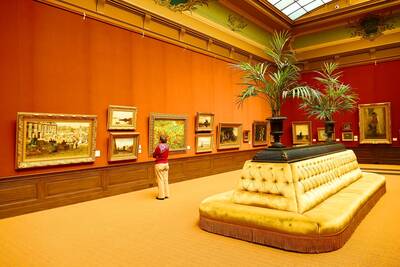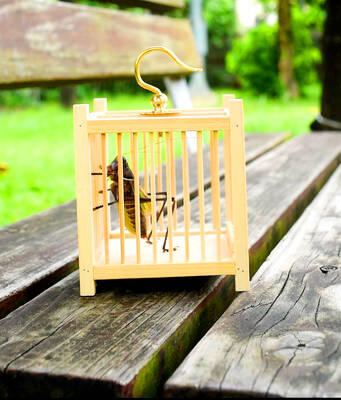對話 Dialogue
馬可:小實,你拿著黑黑、長長的袋子,那裡面是樂器嗎?
Mǎkè: Xiǎoshí, nǐ názhe hēi hēi, cháng cháng de dàizi, nà lǐmiàn shì yuèqì ma?

小實:是啊!這是我的豎笛。
Xiǎoshí: Shì a! Zhè shì wǒ de shùdí.
馬克:哇!我不知道你會吹豎笛,你也參加管弦樂團嗎?
Mǎkè: Wa! Wǒ bù zhīdào nǐ huì chuī shùdí, nǐ yě cānjiā guǎnxián yuètuán ma?
小實:對啊!下個月我們有一場音樂會,你要來嗎?
Xiǎoshí: Duì a! Xià ge yuè wǒmen yǒu yì chǎng yīnyuèhuì, nǐ yào lái ma?
馬克:我很喜歡聽音樂,不過我對古典樂不太熟悉,怕聽不懂。
Mǎkè: Wǒ hěn xǐhuān tīng yīnyuè, búguò wǒ duì gǔdiǎnyuè bú tài shóuxī, pà tīng bù dǒng.
小實:沒關係,我想你一定知道「貝多芬」這位作曲家吧?
Xiǎoshí: Méiguānxi, wǒ xiǎng nǐ yídìng zhīdào “Bèiduōfēn” zhè wèi zuòqǔjiā ba?
馬克:貝多芬我知道啊!我還知道音樂神童莫札特。
Mǎkè: Bèiduōfēn wǒ zhīdào a! Wǒ hái zhīdào yīnyuè shéntóng Mòzhátè.
小實:我們下個月要演出貝多芬的「快樂頌」哦。
Xiǎoshí: Wǒmen xià ge yuè yào yǎnchū Bèiduōfēn de “kuàilè sòng” o.
馬克:嗯……我還是去聽我的流行樂吧!
Mǎkè: Ēn… wǒ háishì qù tīng wǒ de liúxíngyuè ba!
翻譯 Translation
Mark: Xiaoshi, you are carrying a black, long bag. Is it a musical instrument in it?
Xiaoshi: Yes! This is my clarinet.
Mark: Wow! I didn’t know you play the clarinet. Do you also play in the orchestra?
Xiaoshi: Yes! We have a concert next month. Do you want to come?
Mark: I do like listening to music, but I’m not familiar with classical music. I’m afraid I won’t understand it.
Xiaoshi: It’s okay, I think you must know the composer “Beethoven”, right?
Mark: I know Beethoven! I also know the musical prodigy Mozart.
Xiaoshi: We will perform Beethoven’s “Ode to Joy” next month.
Mark: Well. . . I’d better go listen to my pop music!
單字片語 Vocabulary
1. 樂器 (yuèqì) musical instrument
2. 豎笛 (shùdí) clarinet
3. 管弦樂團 (guǎnxián yuètuán) orchestra
4. 音樂會 (yīnyuè huì) concert
5. 古典樂 (gǔdiǎn yuè) classical music
6. 熟悉 (shóuxī) to be familiar with
7. 作曲家 (zuòqǔ jiā) composer
8. 流行樂 (liúxíng yuè) pop music
教材音檔 Audio Files
教材影片 Video Files:
https://www.instagram.com/celc.nou_tw/guide/_/17999106352646292/
實踐大學華語中心提供
By Shih Chien University Chinese Language Center: https://chineseusc.com/

A: Google has unveiled its 2025 Year in Search chart. No. 10 to No. 6 are: Typhoon Podul, Chinese drama “Love’s Ambition,” tariffs, US President Donald Trump and singer Khalil Fong’s death. B: Wow, actress Rosy Zhao’s new drama is so popular. So what are the top five? A: No. 5 to No. 1 are: Gemini, hanzii.net, NT$10,000 cash handout, entertainer Big S’ death and earthquakes. B: Hasn’t Trump topped this year’s most-searched people chart? A: Yup, and he’s closely followed by cheerleader GuoGuo Chiang at No. 2, whose husband Zack Fanchiang is also at No. 8. Apparently, people are curious about her extramarital

In June, headlines shocked the art world when a visitor damaged a 17th-century painting at the Uffizi Galleries in Florence, Italy, while posing for a photograph. This was not an isolated event. Recently, similar disasters have been reported worldwide, from a child damaging a Mark Rothko painting to a tourist breaking an exhibit by pretending to sit on it. Such incidents highlight why museum etiquette is increasingly crucial. First, we must recognize that art and historical objects are fragile. Once damaged, they may never regain their original condition. Many common actions, though harmless at first glance, can have grave consequences. For

A: Compared to Taiwanese, what did Americans search for most in 2025? B: No. 10 to No. 6 are: Tariffs, FIFA Club World Cup, government shutdown, DeepSeek and incoming New York mayor Zohran Mamdani. A: Mamdani is set to take office on Jan. 1. And what are the top five? B: No. 5 to No. 1 are: the One Big Beautiful Bill Act, iPhone 17, Labubu doll, animated blockbuster KPop Demon Hunters and political activist Charlie Kirk’s assasination. A: The only term to appear on both the Taiwanese and US charts is tariffs. A: 跟台灣人相比,美國人都在搜尋什麼? B: 第10到6名是:關稅、FIFA俱樂部世界盃、政府關閉、DeepSeek語言模型、候任紐約市長佐蘭曼達尼。 A: 曼達尼元旦即將就任,前5名是什麼? B: 第5到1名是:《大而美法案》、iPhone 17、拉布布玩偶、動畫片《KPop獵魔女團》、政治活動家查理柯克遇刺。 A: 看來台、美熱搜榜唯一的共同議題就是--關稅! (By Eddy Chang, Taipei

The world is teeming with danger and unpredictability. To safeguard themselves from harm and invite good fortune, people across cultures carry or display symbolic charms and trinkets. It is common to see beckoning cat figurines in stores in Japan, while people in China have historically kept crickets in cages for good luck. Even flora can serve as emblems of luck, with the four-leaf clover standing out as perhaps the most iconic. A clover is a small plant that typically grows 10 to 30 cms in height. While there are many species of clover, the variety that people consider to